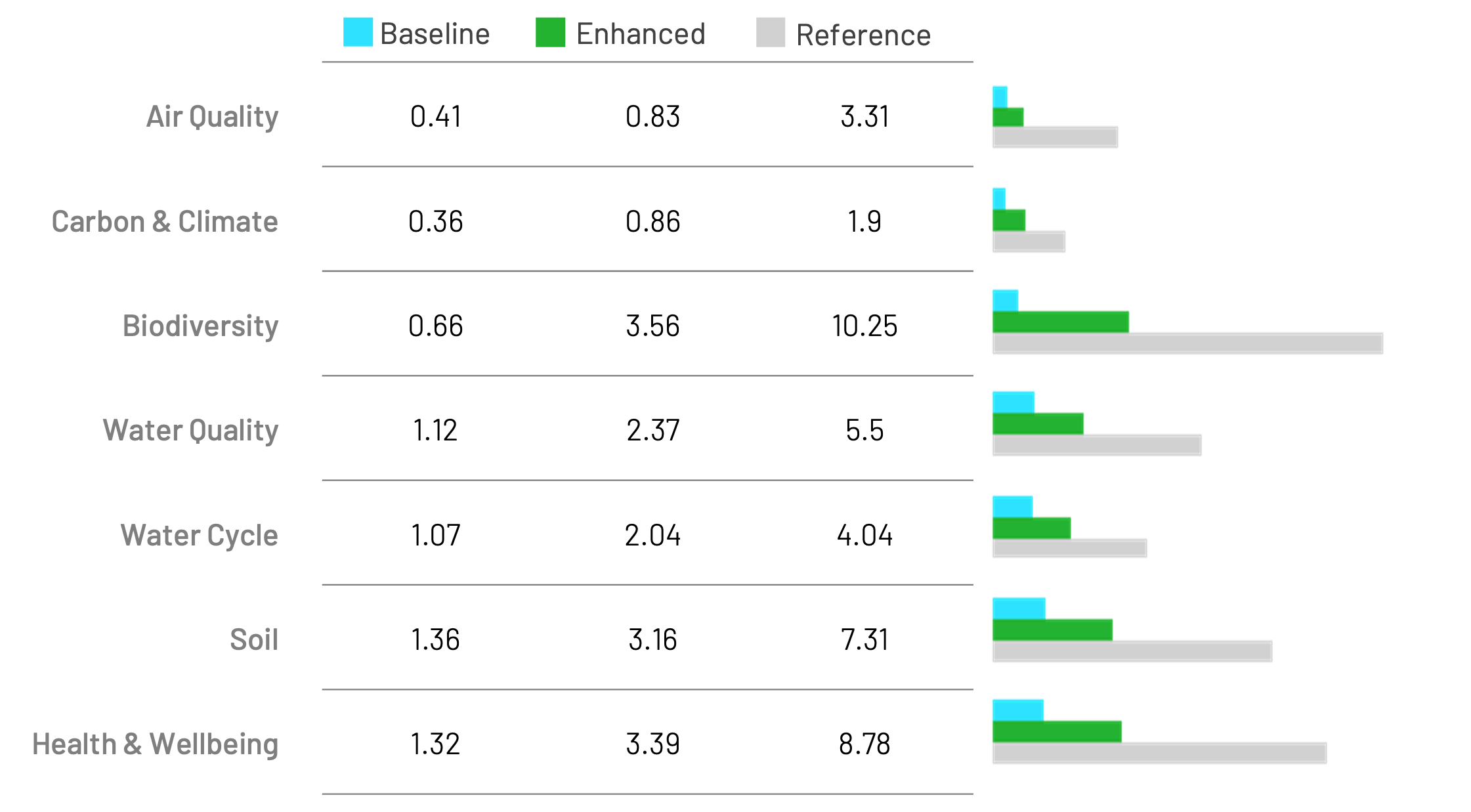
Ecosystem Integrity™ Score
A single measure of how well a site (or portfolio of sites) mirrors the ecosystem service production of high-functioning reference habitats.
Ecosystem Integrity
Using a systems-based understanding of impacts and opportunities, the Ecosystem Integrity Score calculates the co-benefits across 7 ecosystem service categories.
Contextual
Reference performance is based on a global dataset that accounts for the unique balance of ecosystems services in each biome.
Click image to enlarge
Systems-Based
Design scenarios that most closely mirror the reference ecosystem in quantity and quality will score higher.
Click image to enlarge
How it works.
The Ecosystem Integrity Score is a rolled-up calculation of natural benefit production across climate, air quality, water, biodiversity, soil, and social factors.
Ecosystem Integrity Score
Improved scenario includes 0.5 acres Native Tree Restoration in place of 0.5 acres of traditional landscaping, 0.5 acres of herbaceous green roof in place of traditional roof, 1 acre of regreen parking (vegetated pervious) in place of paved surface
Service Acre Summary
Core metric categories.
-
The ability of landscape and design features to filter and protect people from pollutants emitted or mobilized by wind, vehicles, or other forces.
-
Captures three different types of measures:
Biodiversity Support The ability of landscape and design features to support life cycle requirements for a wide range of species groups. This measure incorporates performance values for insects/invertebrates, resident fish, amphibians, reptiles, songbirds, raptors, bats, small mammals, large mammals, and natural plant succession.
Pollinator Support The ability of landscape and design features to support feeding, breeding, and refugia requirements for important pollinator species.
Food Web Support The ability of landscape and design features to support the ecological food web, based on primary production and habitat suitability for each trophic level.
-
Captures the movement of carbon through the landscape:
Carbon Uptake The ability of the landscape to remove carbon from the atmosphere.
Carbon Storage The ability of the landscape to store carbon as organic matter in soil and plant structures.
-
Captures general soil condition and ability to withstand erosion:
Soil Quality General measure of soil condition, based primarily on soil particle sizes (e.g., combinations of clay, silt, sand, etc.), the ability of organic matter to become incorporated into the soil, and the protection of soil biota.
Erosion Regulation The ability of soil to withstand the erosive forces of wind and water, which helps conserve key nutrients and protects water quality. Note that while an impervious surface may protect the soil within a selected survey area from exposure to erosive forces, it can also concentrate runoff from that survey area leading to increased erosion in downslope non-impervious areas.
-
Captures the general ability of the landscape to improve water quality:
Water Quality (Particulate Removal) The ability of landscape and design features to remove particulates, including sediments and other suspended pollutants, from flowing water or runoff.
Water Nitrogen Removal The ability of landscape and design features to remove bioavailable nitrogen from flowing or infiltrated water (in the root zone of plants) through vegetative metabolic processes and/or denitrification.
-
The ability of the landscape to manage and convey a selected storm event (e.g., a 25-year storm). This metric incorporates processes such as interception, evaporation, infiltration and surface storage to predict a landscape's potential for water retention.
-
Captures the ability of the landscape to help improve human comfort and wellbeing associated with thermal comfort, visual disturbances, and noise:
Air Temperature Regulation The localized thermal benefits provided by shading, evaporative cooling, surface albedo, and other natural conditions that affect temperature within an immediate area.
Aesthetics - Visual The extent to which visual disturbance from anthropogenic sources can be screened or blocked by the landscape and natural design features.
Aesthetics - Noise The extent to which anthropogenic noise sources can be screened or masked by the landscape and natural design features.




